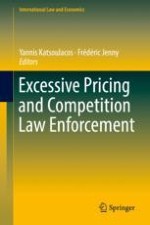2018 | OriginalPaper | Chapter
Excessiveness of Prices as an Abuse of Dominant Position: The Case of India
Authors : Augustine Peter, Neha Singh
Published in: Excessive Pricing and Competition Law Enforcement
Publisher: Springer International Publishing
Activate our intelligent search to find suitable subject content or patents.
Select sections of text to find matching patents with Artificial Intelligence. powered by
Select sections of text to find additional relevant content using AI-assisted search. powered by
